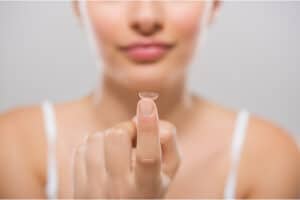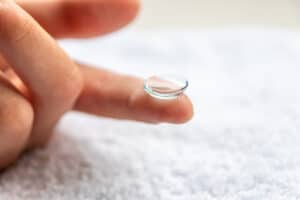There are so many types of contact lenses on the market today, choosing the right kind can be difficult. After receiving your prescription, one of the first things a contact lens wearer must decide is what type of contact lens is right for me, dailies or monthlies?
As their names indicate, dailies are worn as daily disposable contact lenses, whereas a monthly disposable contact lens can be used for up to 30 days before being replaced. Each offers different advantages, and both have pros and cons. The choice you make should be based on your prescription, your lifestyle, and the recommendations of your optometrist.
To get the process going, Eyecare Plus has put together a head-to-head comparison of monthlies vs dailies.
Upkeep: cleaning, disinfecting, and storing
The main difference between dailies and monthlies is the amount of care they need. Monthlies require a daily cleaning routine, and they need to be stored in a little contact lens case each night.
Many eye infections can be prevented with proper contact lens wear and care. Cleaning your monthlies gets rid of debris and protein deposits from your tears that build up and can make the contact lenses uncomfortable and cause potential eye infections.
There is no maintenance for daily disposable lenses.
Advantage: dailies
Durability
Both daily disposable contacts and monthly contact lenses are soft contact lenses, though dailies are made of a slightly thinner material because they don’t have to last as long. The material to make most contact lenses these days is either hydrogel or silicone hydrogel.
Because monthly contact lenses are designed to last up to 30 days, they are slightly thicker than dailies, and are more resistant to rips or tears. Monthlies also usually offer more moisture retention so are more resistant to drying out.
Advantage: monthlies
Cost
Monthly lenses are usually considered the cheaper option because you buy fewer of them. It takes 24 monthly lenses (12 per eye) to supply a years’ worth of monthly disposable contacts, while a year’s worth of dailies is 720 lenses (or 360 pairs a year).
So, monthlies are cheaper. But the price difference is not as big as it seems. Monthly contact lenses need storage cases, travel supplies, and contact lens solutions too, and these items can add up. Still, even with these costs factored in, everyday contact lens wearers will usually get a slightly better value out of monthlies.
Advantage: monthlies
Performance
Because daily contact lenses are changed each new day, they don’t have time to wear out, as monthlies do. And there is no time for build-up to develop on daily lenses. Even with proper care, protein and lipid deposits can develop on monthly contact lenses, affecting the sharpness of vision.
Advantage: dailies
Young wearers
For first time contact lens wearers, especially teens or young people, most optometrists recommend daily disposable contact lenses. New users sometimes tear or lose their contact lenses, so for practical and economic reasons, daily disposables are preferable.
Teens (who are not usually known for their exacting standards of hygiene) are usually prescribed dailies.
Advantage: dailies
Overnight wear
Many people wrongly assume ‘monthly contact lenses’ means they put them in at the beginning of the month and take them out at the end of the month. But that is not how they work.
Leaving your contact lenses in can lead to irritation or an infection and deprive the eyes of oxygen.
During the day, eyes open, we are getting oxygen to our eyes constantly. However, when we sleep, the blood vessels in our eyelids are the only way to get oxygen to the surface of our eyes.
A contact lens is a barrier between the cornea (front of the eye) and the nourishing eyelids. While it certainly isn’t dangerous, it is not an ideal situation.
While there are several ‘extended wear’ contact lenses for overnight use, most eye care professionals agree: you should avoid sleeping with your contact lenses in, unless you have specially prescribed orthokeratology contact lenses.
Since contact lens wearers throw away their lenses at the end of the day, there is no temptation to keep them in overnight.
Advantage: dailies
Environmental impact
We all want to do our part, and with any disposable product, many people are concerned about the environmental impact of wearing contact lenses.
First off, contact lenses weigh about 30 micrograms, and it has been calculated that contact lenses only comprise about 0.5% of the total environmental waste. Probably more surprising, when you compare the environmental impact of dailies or monthly contact lenses to glasses, the contact lenses come out way ahead.
A year’s worth of daily disposables (365 pairs) would add up to about nine grams of plastic – a little less than the amount that goes into two credit cards.
At the same time, monthly contacts require plastic contact lens case, plastic bottles of multi-purpose solution throughout the year.
When the packaging and blister packs are properly recycled, and the contacts are properly disposed of (never flush contacts down the toilet or throw them down the drain), dailies are the surprise winner.
Advantage: dailies
Convenience
Dailies are not only more convenient than monthlies, they are also more convenient than almost anything, ever.
One time wear, put them in in the morning and throw them away at the end of the day. There are no solutions to buy, carry around and use.
Dailies also free you up to wear glasses one day and contacts the next.
Advantage: dailies
Dailies vs Monthly contact lenses: pros and cons
Monthly Contact Lenses PROS
- Great value for money, especially if you wear your contacts everyday
- Durable
- Lower annual cost on average than daily disposable contact lenses
Monthly Contact Lenses CONS
- Performance goes down the longer they are worn
- Wearers need to adhere to a replacement schedule
- Need to be cleaned daily
Daily Contact Lenses PROS
- Hassle free. No need to clean and store
- No need for contact lens solutions
- A fresh pair every day
- Great for new contact lens wearers and young people
Daily Contact Lenses CONS
- More upfront costs than monthlies
Talk to your Eyecare Plus optometrist
No matter what you decide, there are plenty of daily and monthly contact lens options. When it comes to choosing the right contact lens types for you, it is important to see a well-trained and qualified optometrist.
Book an appointment with your local Eyecare Plus optometrists who will make sure you choose the right contact lenses in terms of the fit, size and material that matches with your lifestyle and are healthiest for your eyes.




